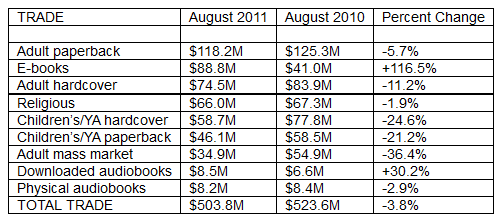eBooks Make Up 18.3% of Book Market for 2011 YTD

Time for the latest update in the sales stats for the eBook versus Print showdown. Month after month we've been hearing of consistent gains for the digital segment, while print editions have fallen steadily, often at double-digit rates. The chart above shows the figures just released by the Association of American Publishers for August as compared to last year, with every physical division experiencing declining sales, while the digital segments (ebooks and downloaded audio) both grew by significant amounts. This has become the norm rather than the exception for the past few years.

Looking at the Year-To-Date numbers for 2011 relative to 2010 you can see the cumulative result: every print division is down by double digits, save Religious titles, which show a moderate gain. More importantly, eBooks have seen an increase of 144% since the first of the year, from $265.7 million to a whopping $649.2 million, making it the second largest segment of the book market overall, behind only Adult Paperbacks. Of course, "eBooks" includes the digital equivalent of every one of the other categories, so it's not a direct comparison of, say, print Adult Paperbacks to digital Adult Paperbacks. Also bear in mind these figures don't take textbooks into account. But as a segment of the general book trade it's a substantial chunk.
And this got me to wondering just where eBooks stood as a percentage of that market. For 2010 the general estimate was that eBooks made up somewhere between 12-15% of total book sales for the year (the numbers are always a bit dodgy, since a lot of figures aren't reported, such as self-pubbed books and those from smaller independent publishers). Doing some quick math you'll see that eBooks' $88.8 million take for August comprises 17.6% of the pie. Discounting audio and comparing digital to print alone brings eBooks' slice to 18.3% for August.
For the Year-To-Date the figures are even more impressive (or depressing, depending on your take), with eBooks' $649.2 million accounting for 18.3% of total sales and 19.04% of non-audio sales, creeping very near that 20% mark. But as I've said before, these are only numbers; since eBooks are priced on the whole far lower than print across the board (often very much lower), the comparison of units sold would tell an even more astounding tale: with eBooks priced on average half or less than their equivalent print edition, those numbers are very likely closer to a 40/60 split between print and digital, if not higher.
The good news for everyone in all this is that people are reading more than ever, despite an overall loss of 3.7% of sales. The AAP's recent survey showed that some 36% of e-reader users now read more than they did before they purchased their device (it's certainly true for me, and I've always read a lot). That's due partly to lower prices per book, allowing them to purchase more titles for their dollar, as well as having an ever-ready source of new material always at their fingertips - no need to make a special trip in to the bookstore for a new read, just click and go. The prevalence of $2.99 or lower titles removes much of the resistance to making that impulse buy. And having invested a hundred or more bucks into that device it behooves the owner to use it and justify the purchase. I find there's also a bit of pride involved for most owners of any new technology, and showing it off is half the fun of having it. eBook readers are no different.
The good news for print aficionados is that physical books still account for 77.9% of all books sold. That's a lot of print books being sold. Just don't expect to ever see that percent again.

Published on October 31, 2011 16:50
No comments have been added yet.



